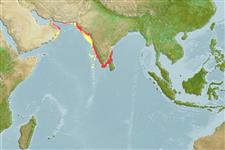Preferred temperature (Ref.
123201): 22.1 - 26.7, mean 24.7 °C (based on 63 cells).
Phylogenetic diversity index (Ref.
82804): PD
50 = 0.5000 [Uniqueness, from 0.5 = low to 2.0 = high].
Bayesian length-weight: a=0.00692 (0.00590 - 0.00811), b=3.03 (3.00 - 3.06), in cm total length, based on LWR estimates for this species (Ref.
93245).
Nível Trófico (Ref.
69278): 2.4 ±0.22 se; based on food items.
Generation time: 1.2 (1.1 - 2.0) years. Estimated as median ln(3)/K based on 19
growth studies.
Resiliência (Ref.
120179): Médio, tempo mínimo de duplicação da população 1,4 - 4,4 anos (K=0.5-1.4; tm=2; tmax=3; Fec=19,028).
Prior r = 0.46, 95% CL = 0.31 - 0.69, Based on 1 full stock assessment.
Fishing Vulnerability (Ref.
59153): Low vulnerability (17 of 100).
🛈
Climate Vulnerability (Ref.
125649): Moderate to high vulnerability (53 of 100).
🛈
Nutrients (Ref.
124155): Calcium = 243 [124, 369] mg/100g; Iron = 1.94 [1.13, 3.42] mg/100g; Protein = 20.2 [19.2, 21.2] %; Omega3 = 0.302 [0.145, 0.589] g/100g; Selenium = 130 [68, 257] μg/100g; VitaminA = 22.9 [6.9, 69.7] μg/100g; Zinc = 1.3 [0.9, 1.8] mg/100g (wet weight); based on
nutrient studies. 